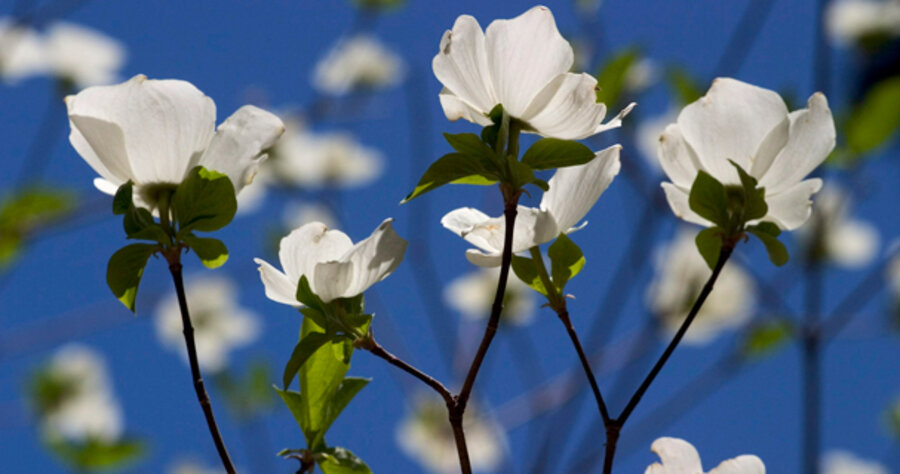Gardens to enjoy after dark
Loading...
| Des Moines, Iowa
Many of us are so busy that we do not have the time to truly enjoy our gardens. For some, the garden is another chore on the "to do" list. If your day is filled with activities and appointments, the best solution may be an evening garden or nightscape – a garden that will delight you from sunset to sunup. Even if you live in the cold North, with a little planning you can enjoy it year-round, from indoors or out.
A garden planned for night interest is uniquely different at night than it is during the day. It relies heavily on contrast – light against dark and dark against light.
My first memories of an evening garden hark back to childhood. I remember looking out my second-story bedroom window in summer – after I was supposed to be asleep, of course – and being mesmerized by the sights, sounds, and scents. We had a narrow garden that abutted a three-foot-high, white brick wall topped by white trelliswork. I watched the moonflowers (large night-blooming cousins of the morning glory) slowly unfurl along their vines. The contrast of the six-inch-wide flowers against the dark green, heart-shaped leaves was brilliant. Once open, they gave off a wonderfully sweet aroma that wafted up to my window. I also might glimpse a sphinx moth (resembling a brown hummingbird) or a magnificent pale-green luna moth come to drink nectar from the flowers. Even in winter, the bare white trellis stood out against the dark sky.
That garden was pretty in the daytime, too, but took on an otherworldly feel at night. Old-fashioned flowering tobacco bore candelabrum of narrow trumpet-shaped blooms that looked fine in daylight but perked up at night, emitting their sultry sweet smell. The yellow marigold globes appeared to be floating on air as their dark foliage blended with the darkening sky.
'Hardscape,' plants, lighting
In designing a nightscape, you are creating an illusion. The three elements vital to that illusion are the hardscape, plants, and lighting. The hardscape includes all the nonplant material that forms the garden – walls, trellises, paths, borders, water.
A nightscape includes plants with attributes that are appreciated more at night. One thinks primarily of white flowers, which appear to glow in the moonlight. Yet, depending on the primary viewing time of the garden, some colors do amazing things. Shades of pale purple, blue, and mauve seem to fluoresce in the waning light of day. Late-afternoon sun brings a warm glow to red and orange flowers. Dark colors, however, all but disappear with the sun. The true stars of a nightscape are the plants that either bloom or are fragrant only at night.
It isn't necessary to tear up a perfectly satisfactory garden and replace it with a nightscape. Instead, add some plants that shine at night. Plant a few spring- to summer-blooming clematis, such as the pale pink Nelly Moser, along with sweetly scented autumn clematis by the front of the garage to greet you when you arrive home. Anchor them to a dark-colored trellis so they'll stand out. Add a variegated red-twigged dogwood; its leaves are eye-catching from late spring through fall, and the stems glow in the late afternoon winter light.
Depending on where you live, some silver-leafed plants, such as lamb's ears, dusty miller, and artemisias (Silver King and Powis Castle are favorites) keep their leaves year-round. The light color shows up even on the darkest nights.
Night gardens not just for summer
Most people think that an evening garden is a summertime indulgence. With carefully chosen plants, you can enjoy the garden all year: small snowdrops and white crocuses in a winter garden, the light portions of variegated hosta leaves that take on surreal geometric forms in the darkness in spring and summer, provocatively perfumed tuberoses in summer and early fall, and the sinuous branches of leafless dwarf Japanese maples or the contorted "arms" of Harry Lauder's walking stick in fall and winter. Their forms are striking when viewed against a white wall or silhouetted against the night sky.
Why limit outdoor lighting to the holidays? Strands of lights wrapped loosely around tree branches add pizazz any time. The lights never fail to bring a smile to my face when I gaze out at them as I'm going through the mail on a late autumn or winter evening. I don't take the lights down, but don't illuminate them every night. It is fun to surprise guests with them at a midsummer dinner alfresco.
Plant for evening scents
Scent plays an important role in the garden. The perfume that fills the night air was not intended for human enjoyment but to attract nocturnal pollinators. When I lived on Long Island in New York, I put a Carol Mackie daphne near the deep end of our swimming pool. In early May, I would take nighttime swims. My reward for swimming laps was inhaling its sweet fragrance as I came up for air.
Breezes often come up as the sun goes down, especially in summer, adding the final dimension to the garden: sound. Imagine rustling bamboo, swishing ornamental grasses, murmuring hemlocks, or soughing pines masking the sounds of the hustle-bustle world outside your garden. A small fountain or water feature adds a lovely burbling sound day or night.
Plants for evening enjoyment
Architectural form (plant them so you can enjoy their silhouettes):
Bamboo
Curly willow
Harry Lauder's walking stick Japanese maple
Ornamental grasses
White birch
Yucca
White and pale colors
Doublefile viburnum
Candytuft
Clematis (especially Henryii and sweet autumn clematis)
Lilacs
Snowdrop
Star magnolia
White rose
White eggplant
Bright colors for sunset
Cardinal flower
Coleus
Daffodils
Red-twigged dogwood
Zinnias
Silvery foliage
Dusty miller
Lavender
Lavender cotton
Russian sage
Sage
Artemisia 'Silver King'
Variegated foliage
Nasturtium 'Alaska'
Hosta
Ornamental kale
Snow-on-the-mountain
Night fragrant
Abyssinian gladiolus
Daphne (Carol Mackie)
Heliotrope
Peacock orchid
Tuberose
Night bloomers
Angel trumpet
Datura
Evening primrose
Flowering tobacco
Four o'clocks
Moonflower





